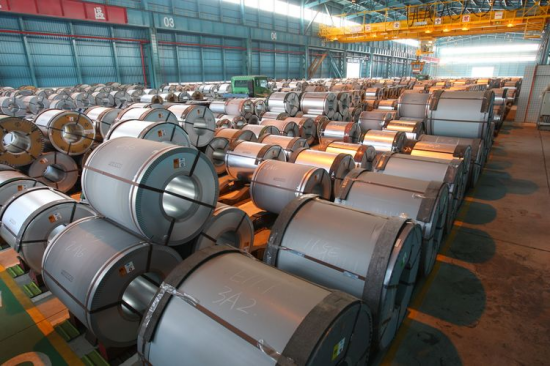【Steel Miscellaneous Talk】Why Are Developed Countries Exiting Steel Production?

Graphite electrodes are essential in electric arc furnace steelmaking, serving as the core component for arc heating. With excellent conductivity and high-temperature resistance, they play a vital role in ensuring molten steel quality and boosting production efficiency. Controlling graphite electrodes means controlling the key to eaf steelmaking.
【Steel Miscellaneous Talk】Why Are Developed Countries Exiting Steel Production?
Have you noticed that the current situation in the steel industry seems to be turning into a secret no one dares to talk about? Developed countries are one after another choosing to exit steel production. What exactly has made this once incredibly glorious industry so "miserable"?

Look at this: even the United States and Germany have already deindustrialized, shifting to the service sector and technology industries. But what about China? Steel still remains the "lifeline" supporting the economy. Yet the question is, even though steel is so important, why are so many countries unwilling to continue producing it? It's not just that the market is difficult—it also involves environmental protection, costs, labor, and a whole series of headaches. You tell me, how hard is this business really?
On one hand, steel is the backbone of traditional industry. Whether it's construction, automobiles, high-speed rail, or national defense, which industry can survive without steel? But on the other hand, the steel industry is indeed a "heavy burden."
Take China, for example: steel annual output ranks first in the world, with production value exceeding trillions of yuan, but profits are pitifully low. In 2024, the total profit of key steel enterprises was only 42.9 billion yuan, a year-on-year decrease of half. The average sales profit margin was just 0.71%. You read that correctly—0.71%! This is the reality of the steel industry: low earnings, huge investment, and slow returns.
Want to build a modern steel plant? You have to invest hundreds of billions of yuan, with a payback period of at least a decade. Moreover, the work is dirty and labor-intensive, so young people are not willing to do it—they'd rather deliver takeout. Environmental pressures are also suffocating; steel accounts for 15% of national carbon emissions, and the West constantly criticizes China for "destroying the environment."
In recent years, developed countries have one by one chosen "deindustrialization." For example, in September 2024, the UK announced the closure of the last blast furnace at Port Talbot, essentially halting its steel industry.
Similarly, steel production has gradually been outsourced to low-cost regions, such as Asia and Eastern Europe. Japan's steel output dropped from a peak of 119 million tons in 1973 to 80% of that level, with significant capacity reduction. Germany's Ruhr area also experienced a decline, with steel production falling from several tens of millions of tons at its peak to about 40 million tons today.
You can see that there are reasons why developed countries choose to exit steel production. The main factors are high costs, environmental pressures, labor shortages, and the migration of capital to developing countries, causing the industry chain to shift outward.
But China is different. Steel is not only an economic pillar but also a symbol of national strength. Look at China's steel output: 1 billion tons per year. This is not just a number—it represents the foundation of a country's manufacturing industry, supporting the economy and employment, especially in major steel-producing provinces like Hebei and Shanxi, where steel directly affects people's livelihoods.
If steel production loosens, many industries will be affected.
Think about history: steel has always been the "pillar" of a rising power. In the 19th century, Britain's steel production accounted for 60% of the world's total, supporting a powerful fleet. During World War II, Germany's steel capacity was once the highest in Europe, fueling tank fleets. In the last century, the United States' steel output surpassed half of the global total, overtaking Britain's dominance.
Today, Chinese steel has also become one of the world's strongest forces. It's not just about numbers—it's confidence, proving the strength of China's industrial base.
However, frankly, the steel industry is now facing considerable challenges. The developed Western countries have chosen to abandon it; we cannot simply imitate them.
The profit margin in the steel industry is truly low, like "hard work with huge investment and slow returns." Moreover, it still faces environmental pressure. Carbon emissions are so high, and Western media talk about it every day—annoying, isn't it?
But from another perspective, could this also be a great opportunity for China? With the global transition to new energy, the rise of wind power, photovoltaics, and electric vehicles has sharply increased demand for high-strength steel. China can seize this chance to fill this gap.
Technologies like hydrogen-based steelmaking and carbon capture are already in pilot stages. By 2025, hydrogen-based blast furnaces may make breakthroughs, reducing steel emissions by 80%. The state is coordinating and encouraging R&D, with steel enterprises and universities collaborating on innovation.
Isn't this essentially laying out a "future industry" plan? Moreover, we no longer need to rely on imported steel. We produce it ourselves, controlling the supply chain and not needing to depend on anyone.
Safeguarding the steel industry is safeguarding China's industrial initiative. We must not only maintain competitive advantages in steel production but also continue to advance in green and high-quality development.
Global shifts in the industrial chain provide us with opportunities. Steel is no longer just a synonym for "traditional manufacturing"—it can become greener, smarter, and lead the world.
Feel free to contact us anytime for more information about the EAF Steel market. Our team is dedicated to providing you with in-depth insights and customized assistance based on your needs. Whether you have questions about product specifications, market trends, or pricing, we are here to help.
No related results found








0 Replies